
Nebraska County Fossils
Brown
< Vertebrate Paleontology Home
A virtual journey through the Museum's vertebrate paleontology collection.
Teleoceras major, Barrel-bodied rhino
Family: Rhinocerotidae
Geologic age: Miocene (Clarendonian), about 11 million years old
Year fossil collected: 1926
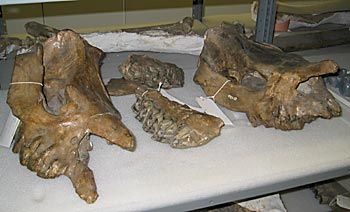
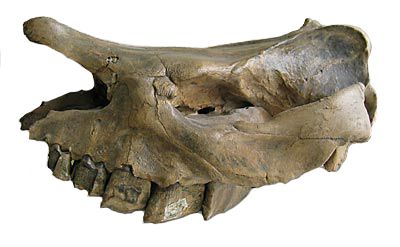
These rhino skulls from Brown County are some of the first fossils ever collected by Morris F. Skinner and James H. Quinn of Ainsworth, Nebraska. When the two young men contacted E. H. Barbour of the University of Nebraska State Museum about their finds, their lives would change forever, as would the scientific legacy of Brown County!
The "Quinn Rhino Quarry", in the Merritt Dam Member of the Ash Hollow Formation where volcanic ash dates range from 10.5 to 11.5 million years, became the starting point for the long and brilliant career of one of Nebraska's premier paleontologists. Teleoceras major, as Skinner and Quinn's rhino would later be named, is the same species as preserved at the Ashfall Fossil Beds in Antelope County. Two skeletons of this Brown County rhino are on display in Morrill Hall.
Gopherus oelrichyi, Gopher tortoise
Family: Testudinidae
Geologic age: Pliocene, about 3 million years old
Year fossil collected: 1989
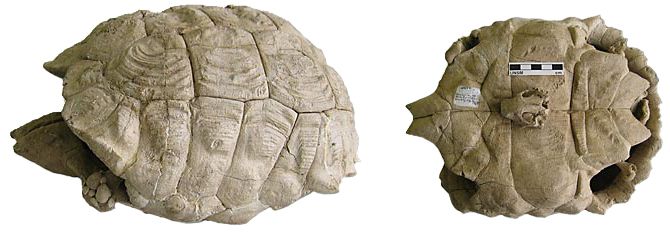
This gopher tortoise (Gopherus oelrichyi) died in its burrow 3 million years ago. It was found north of Ainsworth by paleontologist Morris Skinner in 1989. Nebraska is too cold for such large cold-blooded land animals today, but in the middle Pliocene the climate apparently was much warmer. Gopherus oelrichyi had a strongly-ornamented carapace (below) and plastron (left) and a very small skull (also left).
Barbourofelis whitfordi, Whitford's cat-like sabertooth
Family: Nimravidae
Geologic age: Miocene, about 11 million years old
Year fossil collected: 1913
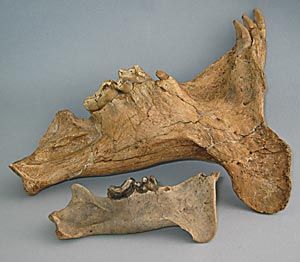
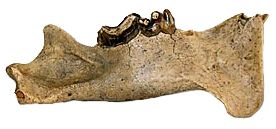
This beautiful jaw of Barbourofelis whitfordi (below) was collected by A.C. Whitford while he was a student at the University of Nebraska studying geology and paleontology under E.H. Barbour. It came from rocks assigned by Morris Skinner to the lower part of the Merritt Dam Member of the Ash Hollow Formation. This very rare leopard-sized predator is the geologically oldest species of North American Barbourofelis--a migrant from Asia. Nebraska specimens document the evolution of barbourofelids in North America: about three million years later, Barbourofelis fricki (top left) was about twice the size and eight times the weight of its predecessor!
Geological Ages of Rock Formations
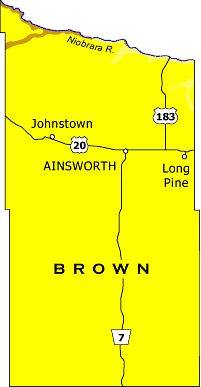
| Q | Pleistocene ("Ice Age") Sands, gravels, silts overlay much of the county (not shown) Pleistocene sands, gravels and silts overlay much of Nebraska and often conceal the bedrock beneath. These "Ice Age" deposits often produce the remains of mammoths, bison, horses, musk oxen, elk and other familiar mammals. Small fossils, especially, are important indicators of the climate at the time of deposition. |
| Tpo | Tertiary, Miocene/Pliocene, Ogallala Group, 2-14 million years old Ogallala Group rocks include predominantly clastic sands and sandstones composed of a mixture of Rocky Mountain debris and locally derived and re-worked sediments. Ash beds are not unusual in the Ogallala and help to precisely date the sediments. In western and southwestern Nebraska, the Ogallala beds are responsible for resistant bluffs that cap the valley sides of modern streams. |
| To | Tertiary, Oligocene, White River Group, 28-40 million years old The White River Group rocks include the Chadron and Brule Formations often form large expanses of low to medium-relief badlands typical of western Nebraska (Toadstool Park) and South Dakota (Big Badlands). Siltstones and very fine sandstones dominate these units. The White River Group rocks preserve the early history of horses, rhinos and camels, all of which originated in North America. The habitats across much of the state at the time were distinctly un-Nebraskan, with low-crowned browsing mammals (forest dwellers) and their predators composing the dominant fauna. |





